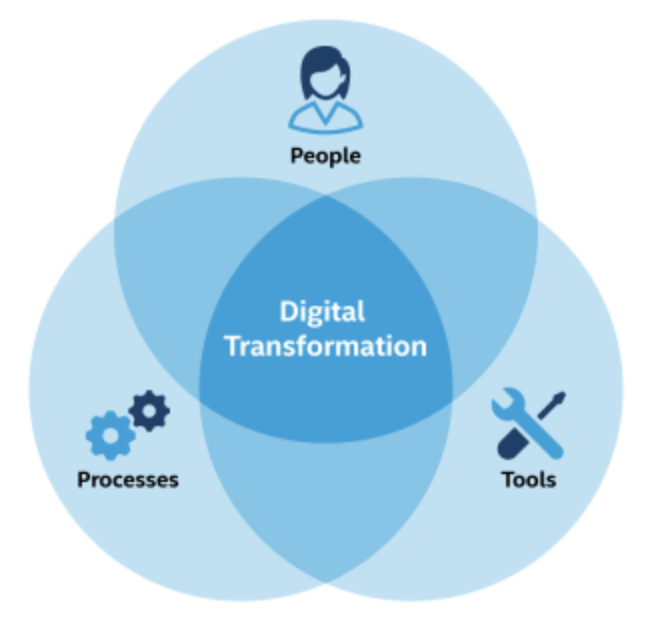What Is Digital Transformation? Everything You Need to Know

The digital age has changed the way we do business. Thanks to technology like cloud storage and artificial intelligence (AI), companies have access to more data and digital tools than ever before. Whether you’re a start-up or a fast-growing enterprise, digital transformation can help your organization succeed.
The problem? Digital transformation can be difficult if you don’t have access to the right support and/or knowledge to help you manage the process.
This guide is here to support your efforts — it walks you through what digital transformation means, the challenges and benefits you may face while rolling out a digital transformation strategy, and how the right digital transformation consultant or expert is key to success.
What is digital transformation?
Digital transformation is the integration of digital business solutions in every area of a business. Some examples: moving from manual human resources and AP processes to digital, transitioning to cloud-based storage, or implementing an effective communication and network system. Digital transformation sits at the center of your people, processes, and tools.
When done well, digital transformation fundamentally changes how your business operates. It impacts your business strategy, company culture, and the value you’re able to provide customers.
What are the benefits of digital transformation?
For many businesses, the main benefits of digital transformation include:
- Operational efficiency
- Customer experience (CX) and user experience (UX)
- More time and resources are available to dedicate to things that require human intervention
With a winning strategy, you’ll discover that digital transformation can also improve:
- Profits
- Market share
- Productivity and efficiency
- Collaboration
- Data collection and accuracy
Digital Transformation Common Challenges
Digital transformation isn’t just adding a few more digital tools to your marketing stack or moving files to the cloud. It’s a fundamental shift in how your business operates — and it may come with a few challenges. Understanding these challenges from the start will help your company prepare for the road ahead.
Which challenges can you expect? Here are a few of the most common:
- Getting buy-in is hard: Getting stakeholders on board — especially if certain leaders are set in their ways — can be difficult.
- Decision paralysis: There are dozens of digital options for just about every system. Which one is right for your business? Finding the right solution can be overwhelming and lead to making no decision at all.
- Training takes time: Moving all your systems to new platforms means staff needs training. If training isn’t effective, mistakes can happen.
- Lack of IT skills: Many companies preparing for a digital transformation don’t have the IT resources necessary to install and maintain the new platforms.
The good news is, most challenges can be overcome by developing a comprehensive digital transformation process. The next section outlines the process companies can use to evaluate their needs and plan for a digital transformation.
5 Steps to Implementing Digital Transformation
Digital technology is no longer a nice-to-have solution reserved for big brands. Every company across all industries should have eyes on digital transformation. With that said, it’s important to note that no single digital transformation implementation process works for every business. However, the following five basic steps can help your company develop a successful digital transformation roadmap so you can implement your custom strategy.
1. Define your overall goals.
What are your company’s digital transformation goals? Think about the benefits we listed above to help you determine exactly what you want to achieve.
Ask questions like: What are the results you expect? How will it help your business? Consider current challenges and long-term issues that might influence your business in five to ten years.
In addition to developing goals, outline specific KPIs to track the success of your digital transformation strategy as they relate to your goals. Are you hoping to see an increase in efficiency or a decrease in waste? How will additional data help your business compete?
2. Assess current capabilities and opportunities for growth.
Next, perform an audit of your current systems and processes. Are any systems failing? Those should be at the top of the list. Where are you losing money or resources? Those areas represent growth opportunities.
Make a list of current systems, software, and assets. Do they fit your current needs? Will they fit your needs in the future? Consider both software (like CRMs) and hardware (servers, computers, etc.).
3. Get buy-in from stakeholders.
Once you understand your goals, it’s time to get buy-in from stakeholders. Many organizations focus on managers’ sign-off, but getting buy-in from the people using the technology on a daily basis is also crucial. That’s because implementing new systems is just one part of the process — users must adopt the new process for your initiatives to succeed.
Adjust your messaging for different groups. For example, executives likely want to know how much money the company will save while staff cares about the impact on their daily work life. How much time will they save? What redundancies will be eliminated?
4. Create a roadmap to outline resources and steps.
Now it’s time to create a strategy. What systems will be added? What resources are required to implement that new system? What program will be initiated first? How many people do you need? What software, hardware, and skills are required to make the change?
This stage is the most complex of the entire digital transformation process, so take your time. Get feedback from teams that own specific processes. They may have insights that can prevent issues down the road.
Make sure you consider any challenges you might face. What happens if certain processes aren’t implemented in time? Create contingency plans to ensure crucial processes won’t be impacted.
5. Prepare for digital transformation and launch.
Communicate your plan with everyone in your company and explain how it will impact each team. Remember that digital transformation isn’t just about changing a few systems around and installing new servers — it fundamentally changes your company’s culture.
Make sure you have a clear plan and timeline for the transformation, run through your contingency plans, and launch!
Digital Transformation Independent Consultants
Digital transformation independent consultants help organizations develop and implement a digital strategy to improve operational efficiencies and help your business grow. The process often includes assessing current business capabilities, including your business model, processes, data management, technology solutions, and future goals.
Then, you’ll work together to outline objectives, locate opportunities, and develop an action plan to move your business into the digital age. Finding the right digital transformation consultant is crucial for implementing digital solutions and for your long-term growth.
So how do you find the right digital transformation consultant? Here are five considerations to keep in mind when looking for the right fit.
1. Expertise in your industry.
Digital transformation requires more than IT experience. It requires a deep understanding of your market and the challenges companies in your industry face. Make sure your chosen consultant understands the nuances of your industry, including the type of clients you serve and unique security challenges.
2. Success with similar clients.
Before hiring, ask to see demos or case studies from past clients. Have they worked with similar companies in the past? How did they handle challenges? What did that experience teach them about working with companies like yours? This may also inform an expected project timeline or even budget.
3. Experience with your current and future systems.
Make sure your consultant has a deep understanding of both your current systems and the ones you plan to install. Legacy systems can be difficult to work with and manage, so make sure they have experience working — and converting— the systems you already have in place. Additionally, make sure they understand the nuances of the new systems you plan to install. They should offer insights into which systems are suited for your organization.
4. Strong communication skills.
Many projects digital transformation projects fail not because of a lack of skill — but rather, a lack of communication. Establishing a communication plan (say a weekly or bi-weekly update meeting) ensures you are on the same page. Ask how the consultant prefers to communicate. Do they offer regular check-ins? What is their process for communicating with internal versus external teams?
Pro tip: Use Catalant’s Expert Marketplace to identify and hire the right digital transformation independent consultant for your organization.
Prepare Your Business For the Future With Digital Transformation
Digital transformation is a complex process requiring expertise and a deep understanding of your business. Establishing a tailored and thoughtful digital transformation strategy and leveraging the support of an experienced consultant are the keys to success.
Want to learn how Catalant can help you find and hire the right digital transformation consultant?
Let’s Talk











